Efficient Distributed Wireless Power Transfer System for Multiple Wearable Sensors through Textile Coil Array
Abstract
:1. Introduction
2. Materials and Methods
2.1. Series Circuit and Parallel Circuit
2.2. Circuit Design
2.2.1. Resonance of Parallel Branche
2.2.2. Resonance of the Whole Circuit
2.2.3. Textile Coil Value and PTE
2.3. Proposed Circuit with PA
3. Results
3.1. Characteristics of Designed Coils
3.2. Experiment
4. Discussion
5. Conclusions
Author Contributions
Funding
Data Availability Statement
Conflicts of Interest
References
- Lin, R.; Kim, H.J.; Achavananthadith, S. Wireless battery-free body sensor networks using near-field-enabled clothing. Nat. Commun. 2020, 11, 444. [Google Scholar] [CrossRef] [PubMed] [Green Version]
- Pantelopoulos, A.; Bourbakis, N.G. A Survey on Wearable Sensor-Based Systems for Health Monitoring and Prognosis. IEEE Trans. Syst. Man Cybern. Part C 2010, 40, 1–12. [Google Scholar] [CrossRef] [Green Version]
- Zhu, Z.; Liu, T.; Li, G.; Li, T.; Inoue, Y. Wearable Sensor Systems for Infants. Sensors 2015, 15, 3721–3749. [Google Scholar] [CrossRef] [Green Version]
- Jung, H.; Lee, B. Wireless Power and Bidirectional Data Transfer System for IoT and Mobile Devices. IEEE Trans. Ind. Electron. 2021, 69, 11832–11836. [Google Scholar] [CrossRef]
- Mardonova, M.; Choi, Y. Review of Wearable Device Technology and Its Applications to the Mining Industry. Energies 2018, 11, 547. [Google Scholar] [CrossRef] [Green Version]
- Wang, C.; Hwang, D.; Yu, Z. User-interactive electronic skin for instantaneous pressure visualization. Nat. Mater. 2013, 12, 899–904. [Google Scholar] [CrossRef] [PubMed]
- Webb, R.; Bonifas, A.; Behnaz, A. Ultrathin conformal devices for precise and continuous thermal characterization of human skin. Nat. Mater. 2013, 12, 938–944. [Google Scholar] [CrossRef] [Green Version]
- Gao, W.; Emaminejad, S.; Nyein, H. Fully integrated wearable sensor arrays for multiplexed in situ perspiration analysis. Nature 2016, 529, 509–514. [Google Scholar] [CrossRef] [Green Version]
- Mukhopadhyay, S.C. Wearable Sensors for Human Activity Monitoring: A Review. IEEE Sens. J. 2015, 15, 1321–1330. [Google Scholar] [CrossRef]
- Majumder, S.; Mondal, T.; Deen, M.J. Wearable Sensors for Remote Health Monitoring. Sensors 2017, 17, 130. [Google Scholar] [CrossRef]
- Gao, J.; Shang, K. Material and configuration design strategies towards flexible and wearable power supply devices: A review. J. Mater. Chem. A 2021, 9, 8950–8965. [Google Scholar] [CrossRef]
- Lee, Y.-H.; Kim, J.-S.; Noh, J. Wearable Textile Battery Rechargeable by Solar Energy. Nano Lett. 2013, 13, 5753–5761. [Google Scholar] [CrossRef] [PubMed]
- Luo, J.; Wang, Z.L. Recent advances in triboelectric nanogenerator based self-charging power systems. Energy Storage Mater. 2019, 23, 617–628. [Google Scholar] [CrossRef]
- Xue, X.; Wang, S.; Guo, W.; Zhang, Y.; Wang, Z.L. Hybridizing Energy Conversion and Storage in a Mechanical-to-Electrochemical Process for Self-Charging Power Cell. Nano Lett. 2012, 12, 5048–5054. [Google Scholar] [CrossRef] [Green Version]
- Lee, J.; Bae, B.; Kim, B.; Lee, B. Full-duplex enabled wireless power transfer system via textile for miniaturized IMD. Biomed. Eng. Lett. 2022, 12, 295–302. [Google Scholar] [CrossRef]
- Komolafe, A. E-Textile Technology Review–From Materials to Application. IEEE Access 2021, 9, 97152–97179. [Google Scholar] [CrossRef]
- Kim, H.-J.; Lin, R.; Achavananthadith, S.; Ho, J.S. Near-field-enabled Clothing for Wearable Wireless Power Transfer. In Proceedings of the 2020 IEEE Wireless Power Transfer Conference (WPTC), Seoul, Republic of Korea, 15–19 November 2020; pp. 22–25. [Google Scholar]
- Harrison, R.R. Designing Efficient Inductive Power Links for Implantable Devices. In Proceedings of the 2007 IEEE International Symposium on Circuits and Systems, New Orleans, LA, USA, 27–30 May 2007; pp. 2080–2083. [Google Scholar]
- Schormans, M.; Valente, V.; Demosthenous, A. Practical Inductive Link Design for Biomedical Wireless Power Transfer: A Tutorial. IEEE Trans. Biomed. Circuits Syst. 2018, 12, 1112–1130. [Google Scholar] [CrossRef] [Green Version]
- Kim, J.; Son, H.-C.; Kim, K.-H.; Park, Y.-J. Efficiency Analysis of Magnetic Resonance Wireless Power Transfer With Intermediate Resonant Coil. IEEE Antennas Wirel. Propag. Lett. 2011, 10, 389–392. [Google Scholar] [CrossRef]
- Kwon, H.; Lee, K.-H.; Lee, B. Inductive Power Transmission for Wearable Textile Heater using Series-None Topology. Electronics 2020, 9, 431. [Google Scholar] [CrossRef] [Green Version]
- Zhong, W.X.; Hui, S.Y.R. Maximum Energy Efficiency Tracking for Wireless Power Transfer Systems. IEEE Trans. Power Electron. 2015, 30, 4025–4034. [Google Scholar] [CrossRef] [Green Version]
- Aditya, K.; Williamson, S.S. A Review of Optimal Conditions for Achieving Maximum Power Output and Maximum Efficiency for a Series–Series Resonant Inductive Link. IEEE Trans. Transp. Electrif. 2017, 3, 303–311. [Google Scholar] [CrossRef]
- Zargham, M.; Gulak, P.G. Maximum Achievable Efficiency in Near-Field Coupled Power-Transfer Systems. IEEE Trans. Biomed. Circuits Syst. 2012, 6, 228–245. [Google Scholar] [CrossRef] [PubMed]
- Low, Z.N.; Chinga, R.A.; Tseng, R.; Lin, J. Design and Test of a High-Power High-Efficiency Loosely Coupled Planar Wireless Power Transfer System. IEEE Trans. Ind. Electron. 2009, 56, 1801–1812. [Google Scholar]
- Khan, H.R.; Qureshi, A.R.; Zafar, F. Design of a broadband current mode class-D power amplifier with harmonic suppression. Analog. Integr. Circuits Signal Process. 2016, 89, 15–24. [Google Scholar] [CrossRef]
- Kobayashi, H.; Hinrichs, J.M.; Asbeck, P.M. Current-mode class-D power amplifiers for high-efficiency RF applications. IEEE Trans. Microw. Theory Tech. 2001, 49, 2480–2485. [Google Scholar] [CrossRef]
- Gupta, A.; Arondekar, Y.; Ravindranath, S.V.G.; Krishnaswamy, H.; Jagatap, B.N. A 13.56 MHz high power and high efficiency RF source. In Proceedings of the 2013 IEEE MTT-S International Microwave Symposium Digest (MTT), Seattle, WA, USA, 2–7 June 2013; pp. 1–4. [Google Scholar]
- Long, A.; Yao, J.; Long, S.I. A 13 W current mode class D high efficiency 1 GHz power amplifier. In Proceedings of the 45th Midwest Symposium on Circuits and Systems, (MWSCAS-2002), Tulsa, OK, USA, 4–7 August 2002; p. I-33. [Google Scholar]
- El-Hamamsy, S.-A. Design of high-efficiency RF Class-D power amplifier. IEEE Trans. Power Electron. 1994, 9, 297–308. [Google Scholar] [CrossRef]
- Raju, S.; Wu, R.; Chan, M.; Yue, C.P. Modeling of Mutual Coupling Between Planar Inductors in Wireless Power Applications. IEEE Trans. Power Electron. 2014, 29, 481–490. [Google Scholar] [CrossRef]
- Fadhel, Y.B.; Bouattour, G.; Bouchaala, D.; Rahmani, S.; Kanoun, O.; Derbel, N. An optimized wearable coil for Wireless Power Transfer Applications. In Proceedings of the 2020 17th International Multi-Conference on Systems, Signals & Devices (SSD), Monastir, Tunisia, 20–23 July 2020; pp. 151–155. [Google Scholar]
- Sun, D.; Chen, M.; Podilchak, S. Investigating flexible textile-based coils for wireless charging wearable electronics. J. Ind. Text. 2020, 50, 333–345. [Google Scholar] [CrossRef]
- Wagih, M.; Komolafe, A.; Zaghari, B. Dual-Receiver Wearable 6.78 MHz Resonant Inductive Wireless Power Transfer Glove Using Embroidered Textile Coils. IEEE Access 2020, 8, 24630–24642. [Google Scholar] [CrossRef]
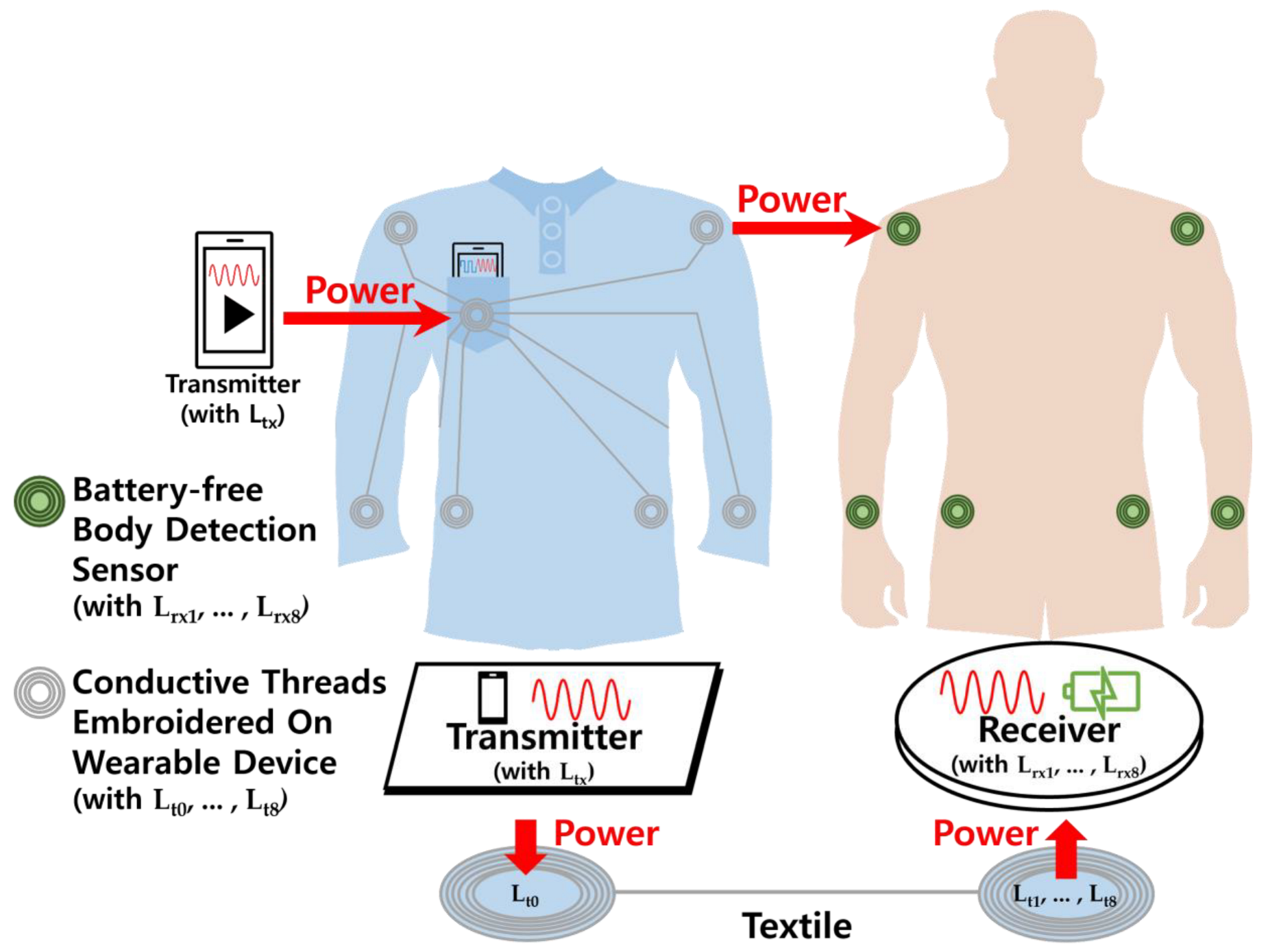

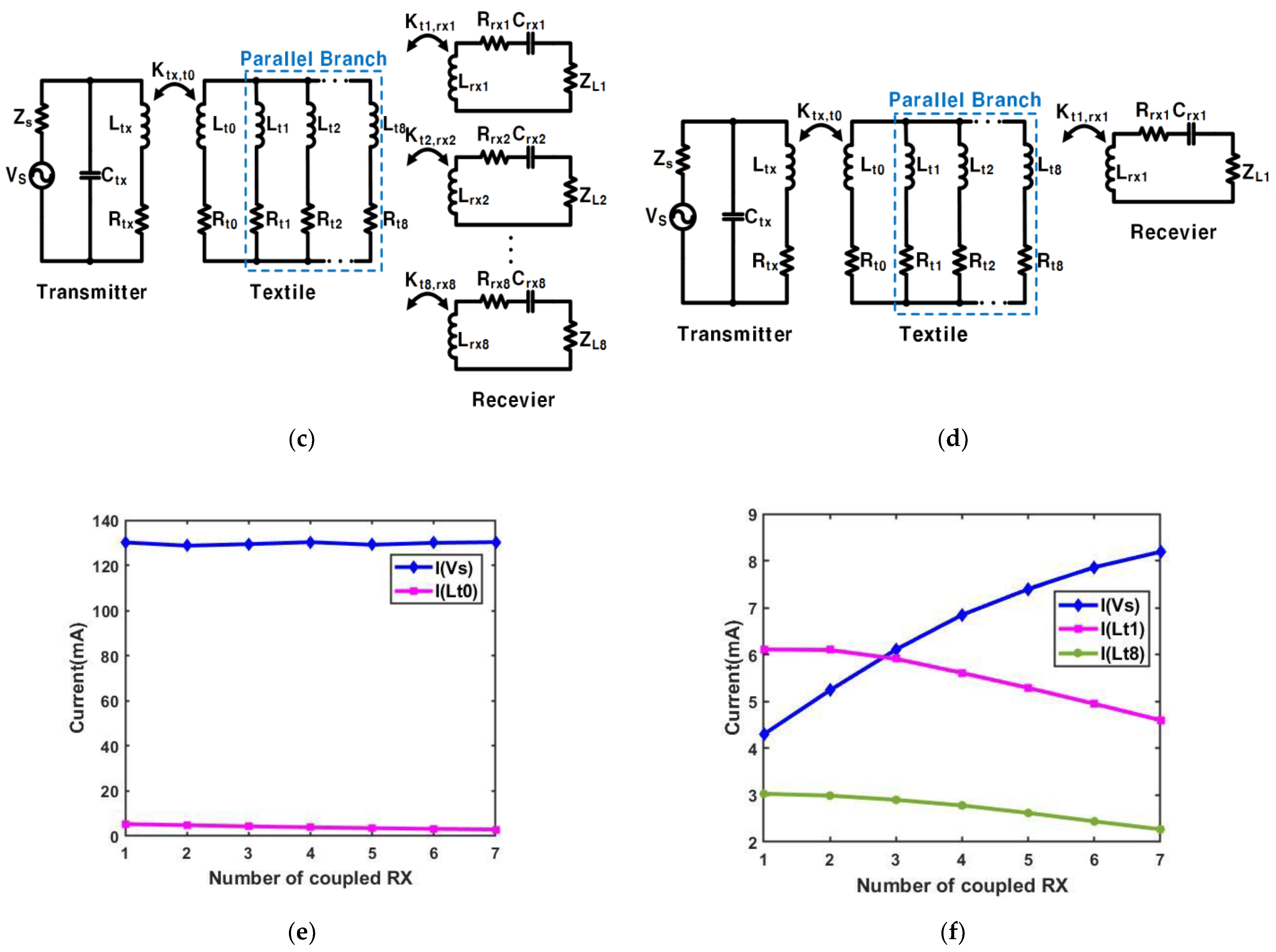
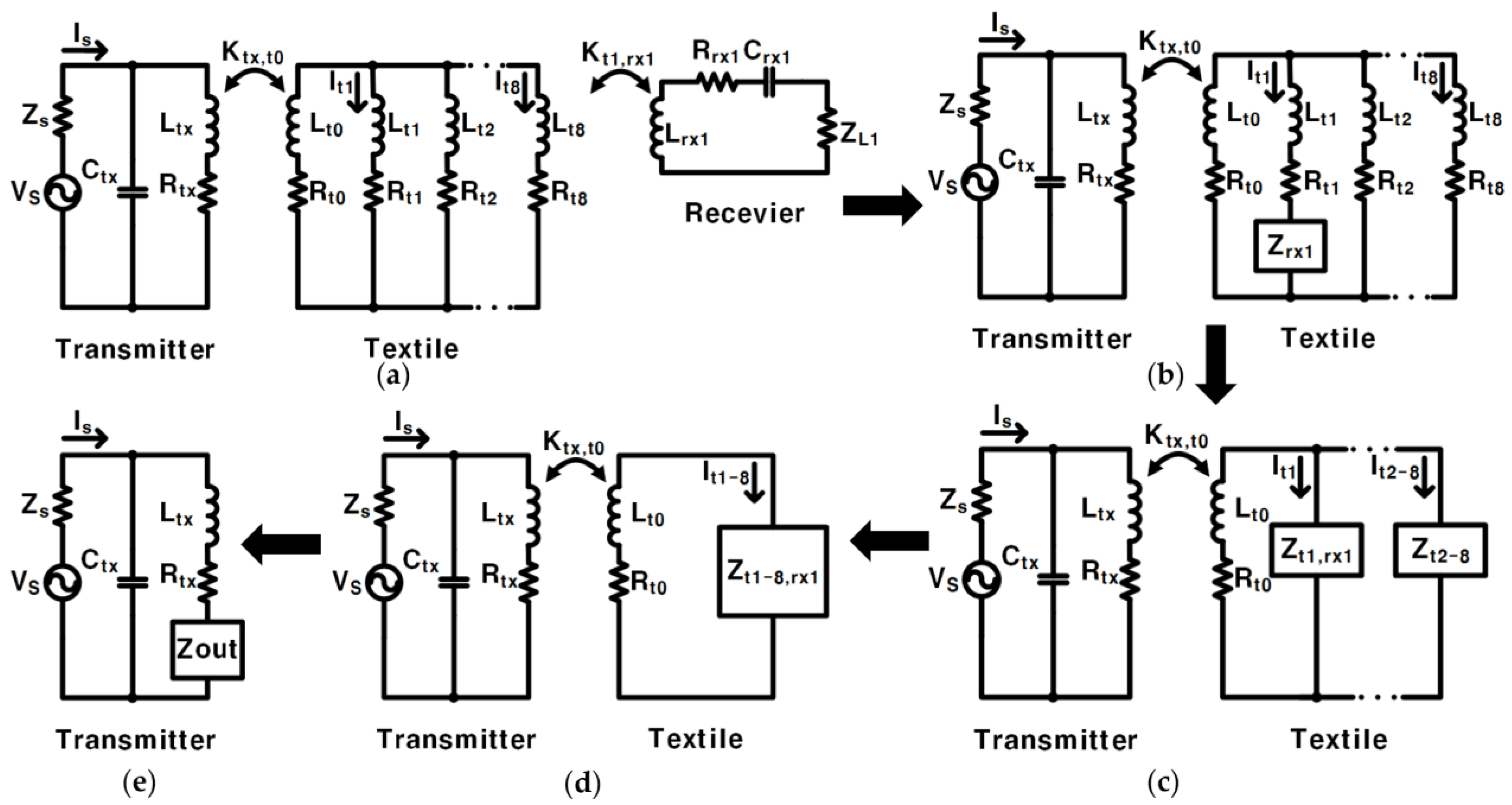
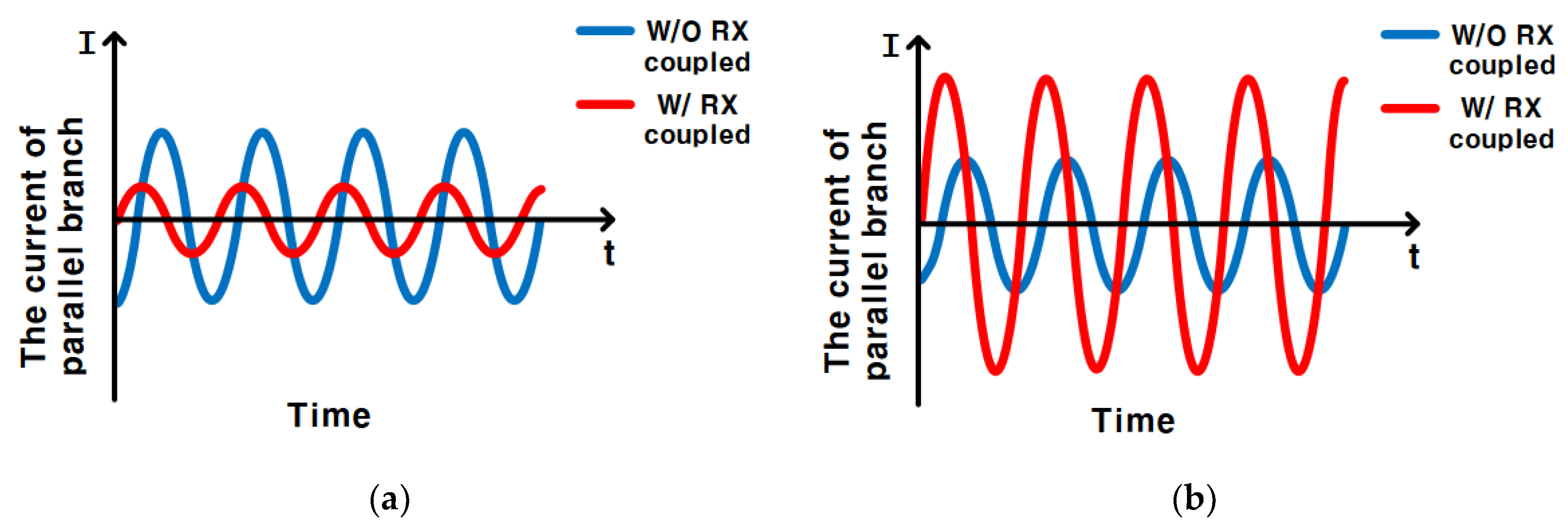

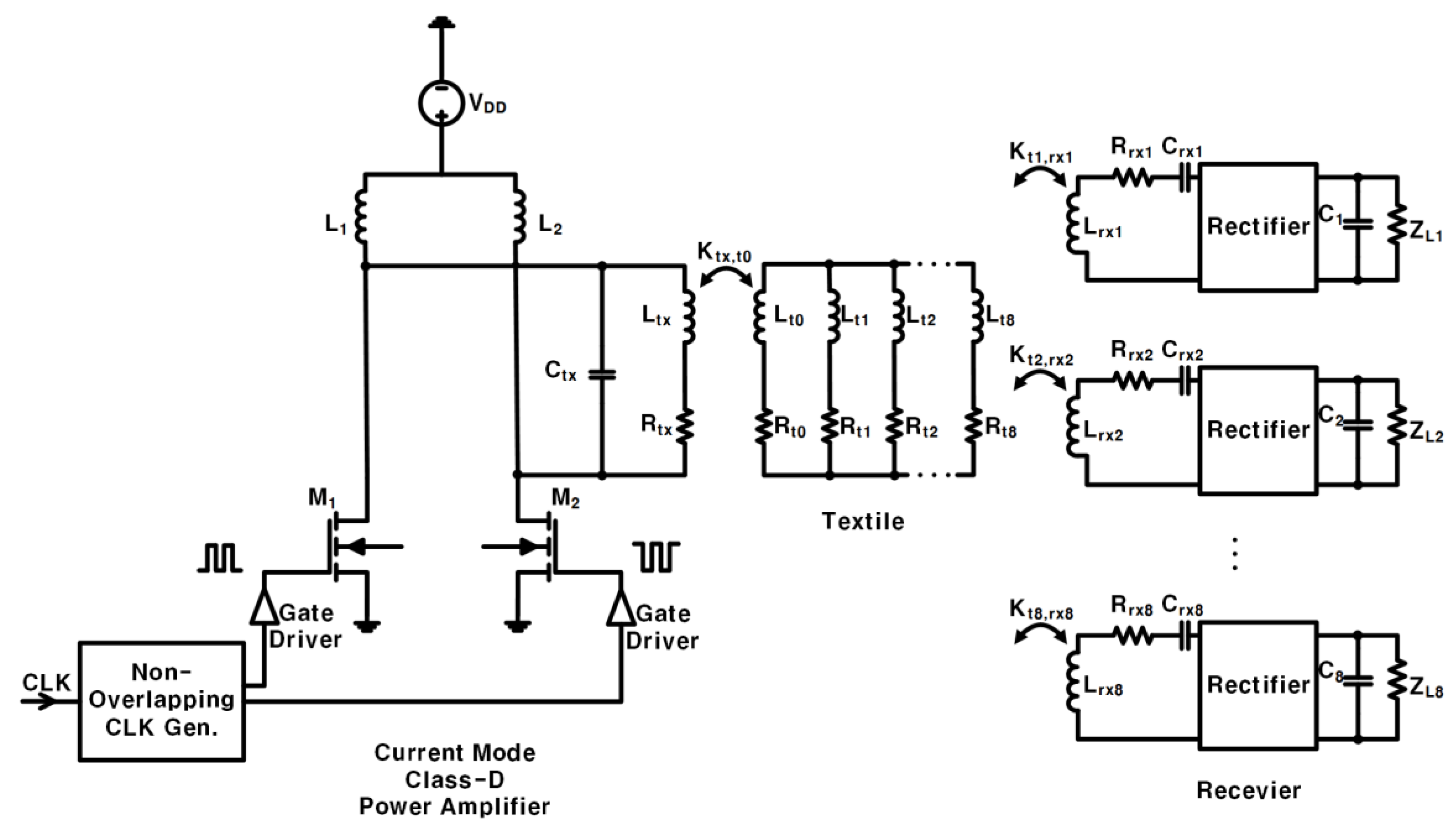


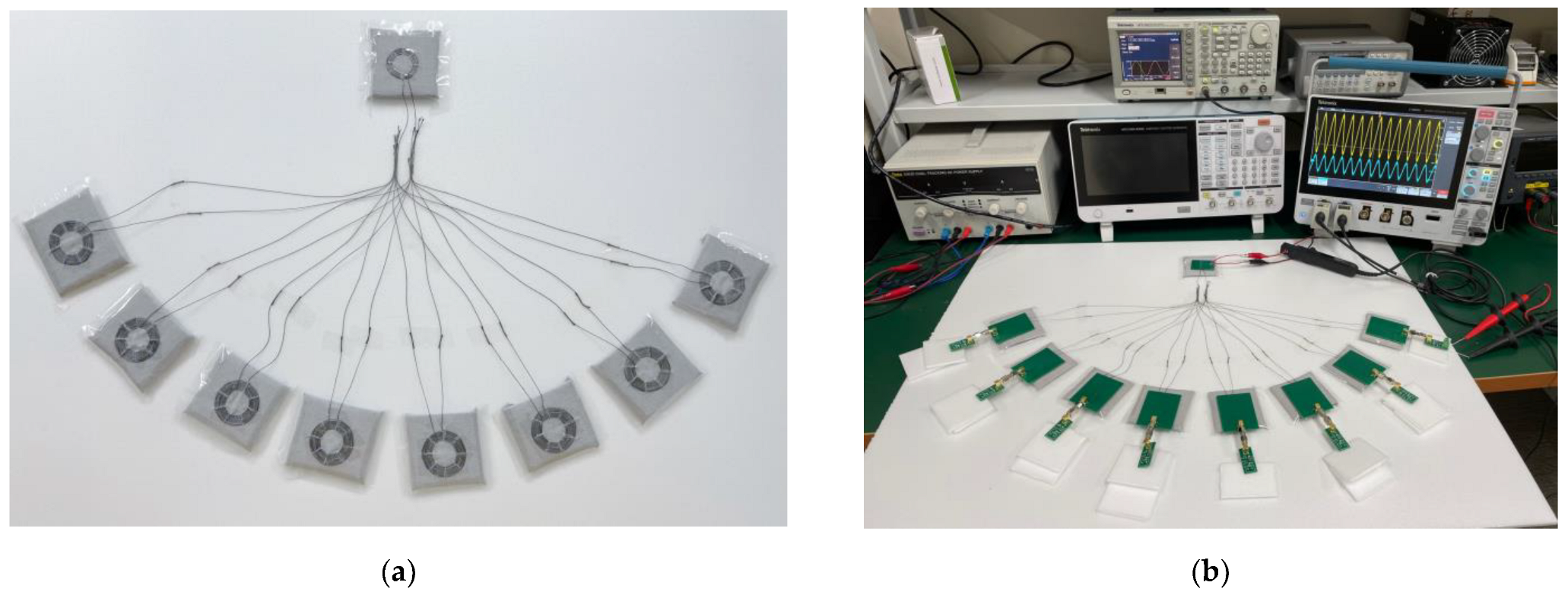
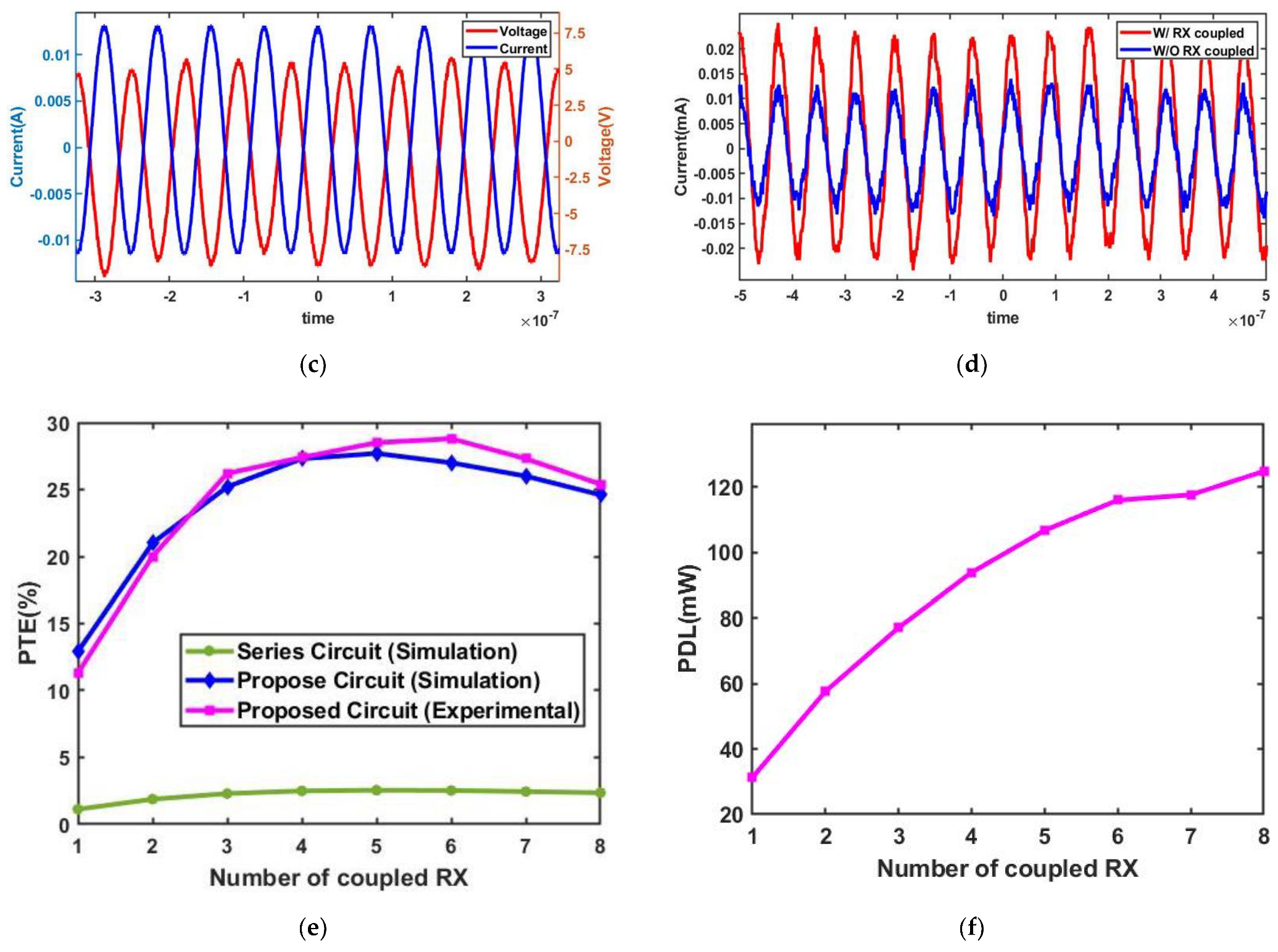
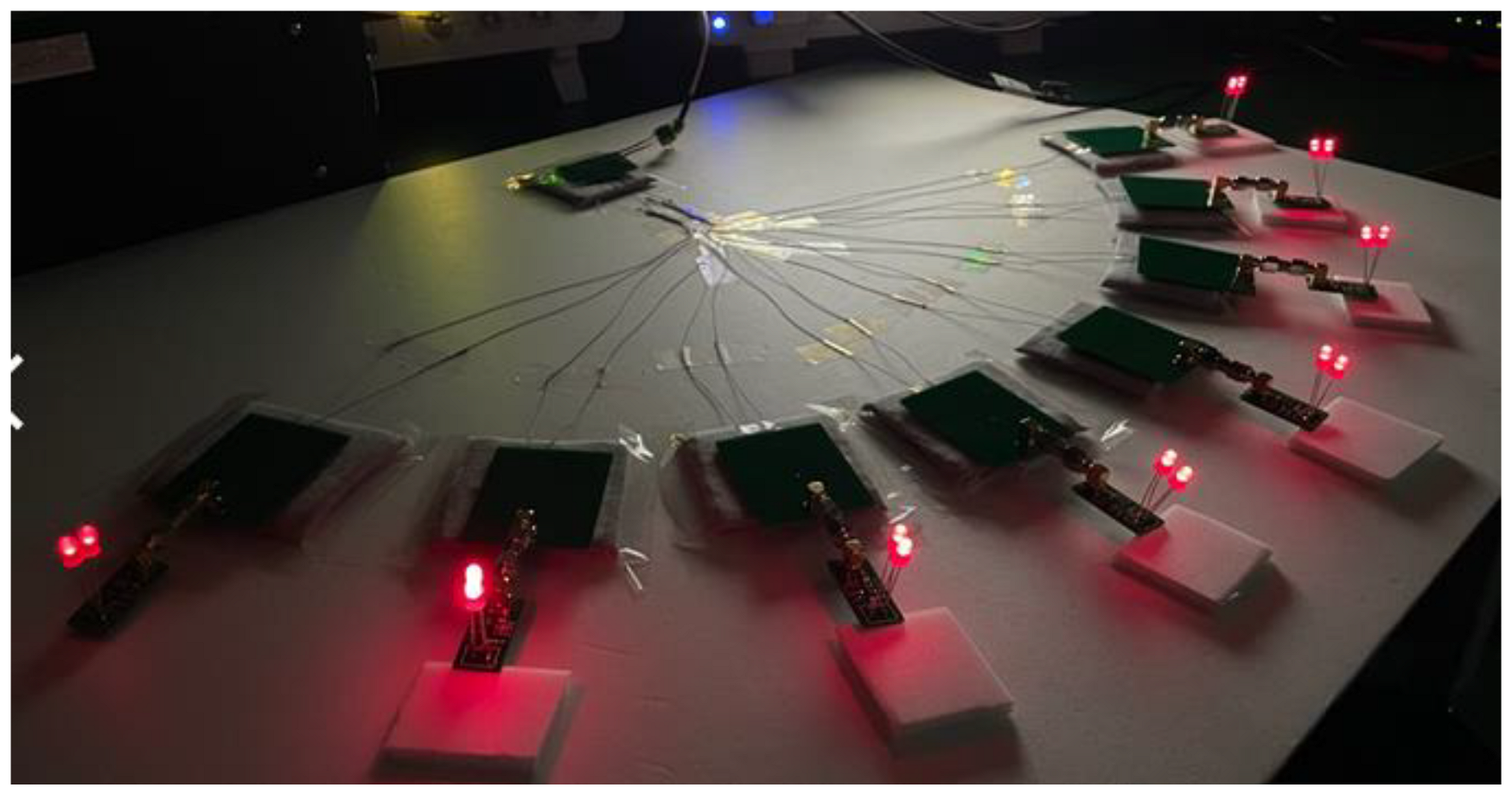
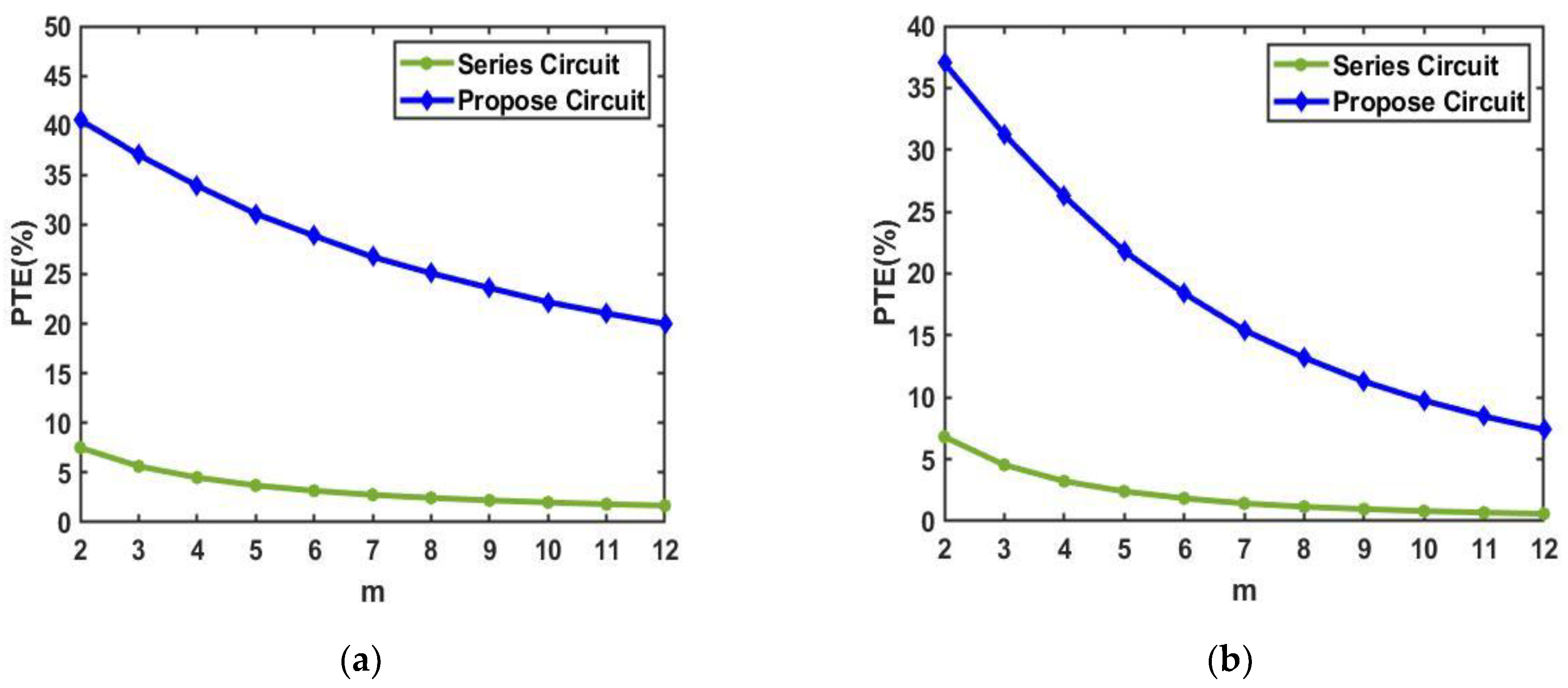
| Parameters | Value |
|---|---|
| TX coil (Ltx) | Inductance = 1.66 μH Parasitic resistance = 2.07 Ω Quality factor = 68.3 Outer diameter = 28 mm Number of turns = 8 |
| RX coil (Lrx1, Lrx2, Lrx3, Lrx4, Lrx5, Lrx6, Lrx7, Lrx8) | Inductance = 3.05 μH Parasitic resistance = 2.92 Ω Quality factor = 90 Outer diameter = 40 mm Number of turns = 8 |
| Textile coil coupled to TX coil (Lt0) | Inductance = 0.791 μH Parasitic resistance = 10.2 Ω Quality factor = 6.61 Outer diameter = 28 mm Number of turns = 4 |
| Textile coil coupled to RX coil (Lt1, Lt2, Lt3, Lt4, Lt5, Lt6, Lt7, Lt8) | Inductance = 3.94 μH Parasitic resistance = 30 Ω Quality factor = 11.19 Outer diameter = 40 mm Number of turns = 9 |
| Source impedance (Zs) | 50 Ω |
| Load impedance (Zl) | 36 Ω |
| Capacitance of Ctx | 96.3 pF |
| Capacitance of Crx | 80.6 pF |
| Coupling coefficient of TX coil and textile coil (Ktx,t0) | 0.5 |
| Coupling coefficient of RX coil and textile coil (Kt,rx) | 0.7 |
Disclaimer/Publisher’s Note: The statements, opinions and data contained in all publications are solely those of the individual author(s) and contributor(s) and not of MDPI and/or the editor(s). MDPI and/or the editor(s) disclaim responsibility for any injury to people or property resulting from any ideas, methods, instructions or products referred to in the content. |
© 2023 by the authors. Licensee MDPI, Basel, Switzerland. This article is an open access article distributed under the terms and conditions of the Creative Commons Attribution (CC BY) license (https://creativecommons.org/licenses/by/4.0/).
Share and Cite
Li, Z.; Lee, J.; Lim, J.; Lee, B. Efficient Distributed Wireless Power Transfer System for Multiple Wearable Sensors through Textile Coil Array. Sensors 2023, 23, 2810. https://doi.org/10.3390/s23052810
Li Z, Lee J, Lim J, Lee B. Efficient Distributed Wireless Power Transfer System for Multiple Wearable Sensors through Textile Coil Array. Sensors. 2023; 23(5):2810. https://doi.org/10.3390/s23052810
Chicago/Turabian StyleLi, Zuolin, Junhyuck Lee, Jaemyung Lim, and Byunghun Lee. 2023. "Efficient Distributed Wireless Power Transfer System for Multiple Wearable Sensors through Textile Coil Array" Sensors 23, no. 5: 2810. https://doi.org/10.3390/s23052810







